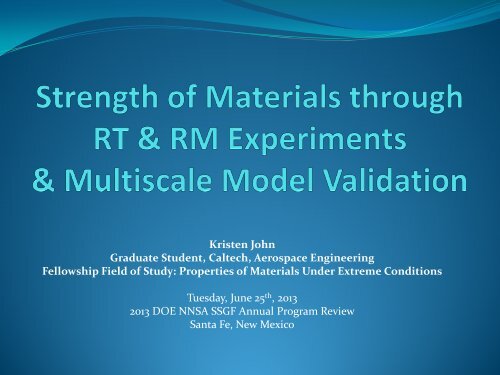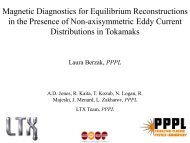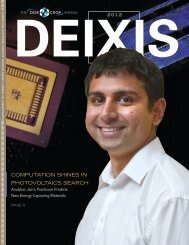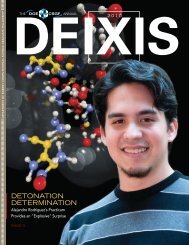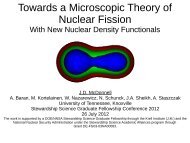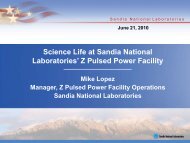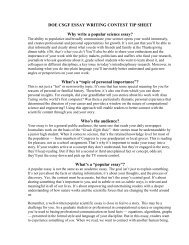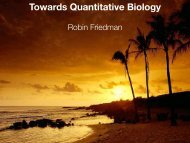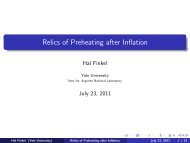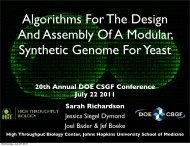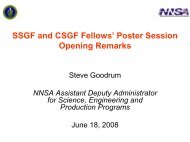Download this presentation (PDF) - Krell Institute
Download this presentation (PDF) - Krell Institute
Download this presentation (PDF) - Krell Institute
You also want an ePaper? Increase the reach of your titles
YUMPU automatically turns print PDFs into web optimized ePapers that Google loves.
Kristen John<br />
Graduate Student, Caltech, Aerospace Engineering<br />
Fellowship Field of Study: Properties of Materials Under Extreme Conditions<br />
Tuesday, June 25 th , 2013<br />
2013 DOE NNSA SSGF Annual Program Review<br />
Santa Fe, New Mexico
Outline<br />
• Motivation<br />
• Objectives<br />
• Omega Laser RT Experiments<br />
• Omega Laser RM Experiments<br />
• Caltech Gas Gun Experiments<br />
• Multiscale Model Validation<br />
• Future Work<br />
• References
Motivation<br />
• Question: What’s the most pressing scientific<br />
challenge facing humanity?<br />
• Stephen Hawking’s Answer: producing electricity<br />
from fusion energy<br />
• The prize is enormous: a near-limitless, pollution-free,<br />
cheap source of energy that would power human<br />
development for many centuries to come.
Hypervelocity impacts,<br />
space shielding<br />
Astrophysics,<br />
Planetary impacts, bodies<br />
ICF, Fusion Energy<br />
RTI’s<br />
Iron,<br />
Earth core conditions (3.5 Mbar)<br />
phase transition<br />
strength at high pressures<br />
New measurement<br />
of strength
Objectives<br />
Omega Laser<br />
Experiments<br />
Multiscale<br />
Model<br />
Caltech Gas<br />
Gun<br />
Experiments
Objectives<br />
Omega Laser<br />
Experiments<br />
-measure of strength at high<br />
pressures for Ta, Fe, and other<br />
materials<br />
Caltech Gas<br />
Gun<br />
Experiments<br />
-measure of strength using<br />
growth of RTI for soft materials<br />
Multiscale<br />
Model<br />
-validate<br />
experiments and<br />
model<br />
-run simulations<br />
to aid in design<br />
of future<br />
experiments<br />
-predict<br />
material<br />
behavior
Omega Laser Experiments
A Collaboration w/ LLNL<br />
• Lawrence Livermore National Laboratory (LLNL)<br />
• My group: NIF Directorate; ICF & HED Science<br />
• Collaborators: Hye-Sook Park, Bruce Remington, Jon Belof,<br />
Rob Cavallo, Brian Maddox<br />
• Practicum: Summer 2011<br />
• Learn how to design laser experiments which will be used to<br />
study the solid-state material properties under high pressure<br />
and high strain rates.<br />
• Participate in laser experiments on the Omega Laser at the<br />
Laboratory for Laser Energetics (LLE) at the University of<br />
Rochester and at the National Ignition Facility (NIF) at LLNL.<br />
• Analyze data from these experiments.
Omega Experience<br />
• Experiments I participated in over<br />
the summer<br />
• RT<br />
• DblPulse<br />
• LattDyn, DynDiff<br />
• ASCEL<br />
• Had to learn how Omega worked<br />
• Diagnostics<br />
• Operations<br />
• Preparation<br />
• OLUG<br />
• Metrology<br />
• Readiness Review Meetings<br />
• Weekly LowT Meetings<br />
• Trips to LLNL
Omega<br />
Rayleigh-Taylor (RT) Laser<br />
Experiments
Omega RT Laser Experiments<br />
• What?<br />
• Studying the strength of Iron & Tantalum at high pressures<br />
(>1 Mbar) and high strain rates (>100 s -1 )<br />
• Quasi-isentropic ramped drive<br />
• Utilizes a reservoir-gap-sample configuration<br />
• Where?<br />
• Omega & Omega EP at LLE in Rochester, NY<br />
• When?<br />
• Past: August 2011, December 2011, August 2012, April 2013<br />
• Future: August 2013
Omega RT Laser Experiments<br />
• Why?<br />
• To determine the strength of Tantalum & Iron (and<br />
eventually other materials) at high pressures and high<br />
strain rates<br />
• Stabilize/reduce RTI growth (via the material strength)<br />
• How?<br />
• By measuring the growth of Rayleigh Taylor instabilities<br />
• Accomplished by putting a ripple in the material and<br />
measuring the growth of the ripple<br />
• Measure the RT growth using face-on radiography
Rayleigh Taylor Instabilities (RTI)<br />
• Instability that occurs when lighter fluid<br />
pushes heavy fluid<br />
• Determine the strength of Ta, Fe at high<br />
pressures and high strain rates by<br />
measuring the growth of RTI<br />
• Accomplished by putting ripple in material<br />
and measuring the growth of the ripple<br />
• Measure RT growth using face-on radiography<br />
λ= 50 µm<br />
η=2 µm<br />
Ref: ICETaRT-09A, HS Park<br />
Ref: SCCM 2011, Ta, HS Park<br />
• Strength can stabilize, reduce RTI growth<br />
Ref: ICETaRT-11A Shot Plan, HS Park
Omega Laser<br />
Ref: Paul Drake, HEDP Summer School<br />
• one of the most powerful and highest<br />
energy lasers in the world<br />
• 60-beam ultraviolet frequency-tripled<br />
neodymium glass laser<br />
• capable of delivering 30 kilojoules at up<br />
to 60 terawatts onto a target less than 1<br />
millimeter in diameter
Experimental Platform<br />
• Laser-driven high pressure platform to compress materials<br />
under near isentropic conditions by ramp compression<br />
• The ripple sample is driven by a ramped drive from a<br />
reservoir-gap-sample configuration. The ripple growth<br />
from the Rayleigh-Taylor instability is measured using faceon<br />
radiography.<br />
• Observational parameter – RTI<br />
• Compare growth measurements with constitutive strength<br />
models<br />
• Deformation under compression<br />
• Macroscopically: can change their yield strength, tensile<br />
strength, ductility, toughness, work hardening<br />
• Microscopically: can change atomic lattice arrangement;<br />
lattice structure can undergo phase transitions when<br />
subjected to high P, T; micro changes have impact on macro
Omega Experiments: Design<br />
• Laser (up to 20 kJ of laser energy) drives strong shock through<br />
low-Z reservoir, which unloads across a vacuum gap, and<br />
stagnates on the sample, generating a nearly isentropic pressure<br />
profile in the sample<br />
Ref: SCCM 2011, Ta, HS Park
Reservoir-Gap-Sample<br />
• Up to 20 kJ of laser energy creates a ramp drive in a reservoir-gap configuration that is<br />
mounted on the side of a hohlraum.<br />
• Reservoir :<br />
• 25 μm thick beryllium ablator<br />
• 200 μm thick 12.5% bromine-doped polystyrene<br />
• Gap<br />
• 400 μm gap<br />
• Ta sample<br />
• 50 μm mean substrate thickness<br />
• preimposed sinusoidal ripple on the driven side<br />
• wavelengths of 50 to 100 μm and 2 μm amplitudes<br />
• sample backed by a 100 μm thick LiF tamper<br />
• Backlighter<br />
• ripple growth measured by face-on radiography<br />
• to probe thickness of sample, we developed a high energy backlighter using the highintensity<br />
short pulse lasers<br />
• for Omega experiment, 22 keV energy was optimal to produce best contrast from our<br />
ripples<br />
• since ripples are 1-D features, we utilize a micro-flag edge-on a 1-D x-ray source aligned to<br />
ripple orientation to generate a bright x-ray source
Omega Experiments<br />
• ICETaRT-11A (8/4/2011)<br />
• Study of Ta material strength dependence on the sample grain sizes<br />
• Why Ta? High density, high melting point, relatively high ductility,<br />
interesting to impact engineering area<br />
• ICETaRT-12B (8/21/2012)<br />
• Study single crystal and Ta material strength at high<br />
strain rates (side-by-side comparison)<br />
• Study Ta material strength and Rayleigh-Taylor growth in a<br />
multimode configuration.<br />
• ICEIronRT-12A (8/22/2012)<br />
• Study of Fe material strength at high strain rates.
Omega Experiments:<br />
Preliminary Results<br />
• Lineouts of the driven and undriven<br />
ripples from λ=50μm ripple region.<br />
The driven ripple growth is evident.<br />
• Ta Rayleigh-Taylor growth factors as a<br />
function of time. Omega data points<br />
are the blue squares. Various material<br />
strength models are plotted for<br />
comparison.
Omega<br />
Richtmyer-Meshkov (RM) Laser<br />
Experiments
Laser Compression Recovery<br />
Experiments for Measuring Strength<br />
of Metals at High Pressures<br />
• Collaborators: Caltech, LLNL, & General Atomics (GA)<br />
Caltech<br />
Aaron Stebner<br />
Kristen John<br />
G. Ravichandran<br />
Bo Li<br />
Brandon Runnels<br />
Michael Ortiz<br />
LLNL<br />
Chris Wehrenberg<br />
Brian Maddox<br />
Bruce Remington<br />
Hye-Sook Park<br />
GA<br />
Greg Randall<br />
Mike Farrell<br />
Paul Fitzsimmons<br />
Abbas Nikroo<br />
Support provided by DOE NNSA through the HEDLP program.
Omega RM Experiments<br />
• Objective: to characterize the strength of metals at pressures<br />
greater than 1 Mbar<br />
• New Richtmyer-Meshkov (RM) and Rayleigh-Taylor (RT)<br />
instability experiment platforms<br />
• Being developed for laser compression recovery experiments to<br />
characterize instabilities, yield strength, and phase transformations<br />
at high pressures<br />
• The multi-scale strength model and code (Eureka) of the Ortiz<br />
group is being used together with 1D hydrodynamic software<br />
(Hyades) to design and analyze RM and RT experiments for Ta &<br />
Fe using these new platforms.<br />
• Through combined analysis of the numerical and empirical data,<br />
fundamental understanding of Ta & Fe strength at high<br />
pressures as it correlates to the development of RT and RM<br />
instabilities, yield strength, and phase transformations will be<br />
advanced.
Omega RM Experiments<br />
• April Experiments<br />
• We performed RM experiments on Ta targets with a single<br />
wavelength rippled surface<br />
• August Experiments<br />
• We will study both Ta and Fe targets with a multi-mode ripple<br />
pattern to study the non-linearity of the ripple growth. The<br />
modes grow independently while the deformation is linear,<br />
then couple in the non-linear growth regime.
Experimental Platform:<br />
“Ride-Along” Recovery Tube<br />
• The basis of the new experimental platforms is a universal “ridealong”<br />
recovery tube.<br />
• The reusable recovery tubes accommodate both RM and RT<br />
target stack configurations developed by the LLNL team for<br />
studying strength of materials at high pressure.<br />
• The tubes are designed to allow these experiments to “ridealong”<br />
next to a primary experiment that does not require all 60<br />
of Omega’s beams. The tube geometries do not interfere with the<br />
primary experiment, and one of the unused beams is used to<br />
drive a shock wave through the target.<br />
• Aerogel catchers enable post-shot target recovery and analysis.
Experimental Platform:<br />
“Ride-Along” Recovery Tube<br />
• Recovery Tube (Cross Section)<br />
• Modeled using SolidWorks; machined at Caltech
Target Stacks<br />
RM Target Stack<br />
(Cross-Section)<br />
RT Target Stack<br />
(Cross-Section)
Target Fabrication<br />
• Rippled surfaces are coined (by General Atomics) into the targets<br />
and characterized pre and post shot. Deformation of the ripples<br />
and changes in material microstructure will be used to<br />
characterize the material strength and deformation mechanisms.<br />
• Single and multimode ripple patterns are designed and coined<br />
into the driven surface of Ta and Fe targets. Deformation of<br />
multimode targets will be used to assess if the drive remained in<br />
the linear vs. nonlinear instability growth, as the modes grow<br />
independently in the linear regime, but become coupled in the<br />
nonlinear regime.
Experiment Design via Simulations<br />
• Experiments are designed by calibrating simulations to drive<br />
shots of similar heat shields and ablators and then predicting<br />
peak pressure and ripple growth as a function of laser energy.<br />
• HYADES Simulations<br />
• Cascade Applied Sciences Inc.<br />
• Radiation hydrodynamics simulation codes for the design and<br />
analysis of laboratory high energy-density experiments<br />
• 1D simulations – design ablators, heat shields, laser energies<br />
• Match VISAR/drive info to produce pressure, velocity, temp profiles<br />
for Eureka<br />
• Eureka Simulations<br />
• Caltech multi-scale model (utilizes engineering model)<br />
• 2D simulations - predict strength and ripple growth
HYADES Simulations<br />
• 1D HYADES simulations are<br />
calibrated to VISAR<br />
measurements, then used to<br />
design ablators, heat shields,<br />
and laser energies.<br />
• In calibrating 1D hydrodynamic<br />
simulations, VISAR velocity<br />
profiles and breakout times at<br />
the rear surface of samples are<br />
matched. Once calibrated, the<br />
1D software is used to calculate<br />
pressure, velocity, and<br />
temperature profiles at the<br />
Heat Shield – Ablator (RM) or<br />
Heat Shield – Reservoir (RT)<br />
interface for laser energies that<br />
correspond to peak pressures of<br />
0.500 – 3.500 Mbar in the<br />
targets.
Eureka Simulations<br />
• Profiles from HYADES used as inputs to the multi-scale strength code<br />
• 2D simulations are run:<br />
• to study predictions of strength<br />
• to ensure the expected ripple growth at the target surfaces will be measurable<br />
in the post-shot target analyses<br />
• to gage limitations in recovery of targets, such as critical energies for melt and<br />
spallation<br />
t = 0.0 ns t = 21.6 ns t = 38.4 ns<br />
2D Eureka simulations predicting strength and ripple growth (GF = 1.4) for the 120 J RM shot.
Target Characterization<br />
• Characterization of the ripple<br />
pattern and microstructure is<br />
done pre- and post-shot using<br />
Wyko<br />
• Provides growth factor<br />
measurements -> used to<br />
gage strength of material<br />
• Insight into active<br />
deformation mechanisms in<br />
metals at pressures 1-4 Mbar<br />
• Comparison with simulated<br />
predictions also validates the<br />
models and experiment<br />
design.<br />
• Post shot simulations used to quantify the drives experienced by<br />
the targets and to correlate the drive characteristics to material<br />
strength including analysis of the role of RT/RM instabilities and<br />
phase transformations.<br />
Characterization of peak-to-valley (PV) amplitudes of ripples
Target Characterization<br />
• As was done for driven<br />
copper (shown left),<br />
microscopy comparing<br />
pre and post shot<br />
microstructures to<br />
characterize dislocation<br />
density, slip system<br />
activity, grain growth,<br />
and twinning is being<br />
performed.<br />
Slip system identification Twin identification<br />
Myers, M.A. et al. Acta Mat. 2003 51 1211-1228.<br />
• White light<br />
interferometry is used to<br />
characterize the ripple<br />
patterns pre and post<br />
shot. From these<br />
measurements, total<br />
growth factor may be<br />
analyzed and used to<br />
gage trends in the<br />
strength of the material.<br />
+70<br />
0<br />
-50<br />
μm
Growth Factor<br />
Analysis Procedure<br />
1. Ripple peaks & valleys are<br />
identified in pre and post shot<br />
interferometry measurements.<br />
2. Wave heights are calculated by<br />
averaging the distance between<br />
neighbor peaks and valleys.<br />
3. Growth factors are assessed by<br />
normalizing post shot wave by<br />
preshot wave heights.<br />
4. Error of the growth factors is<br />
assessed using the mean and<br />
standard deviation of multiple<br />
“line-outs” across the driven<br />
sample.
Simulation & Experimental Results<br />
Shot<br />
Energy (J)<br />
Request/<br />
Actual<br />
Laser λ= 350 nm, 1 ns pulse<br />
800 μm diameter spot<br />
Predicted<br />
Peak<br />
Pressure:<br />
HYADES<br />
(Mbar)<br />
Measured<br />
Growth<br />
Factor<br />
Value(err)<br />
Predicted<br />
Growth Factor:<br />
EUREKA<br />
250/252.9 3.41 1.97(3) NA<br />
200/202.3 2.68 1.72(3) NA<br />
150/153.5 1.96 1.58(7) 1.60<br />
120/118.9 1.52 1.43(6) 1.41<br />
100/95.4 1.23 1.43(4) 1.38<br />
70/56.6 0.98 1.26(4) 1.13<br />
• Resulting expected laser energy – peak pressure relations calculated<br />
using HYADES for our April 26, 2013 RM experiments are listed<br />
together with predicted and measured growth factors.
Simulation & Experimental Results<br />
Peak growth factors exhibited by Ta. The experimental<br />
observations agree with simulated predictions of strength trends.
Caltech Gas Gun Experiments
Gas Gun Experiments: Background<br />
• Goal: Impact sample with ripples, watch ripple<br />
growth, correlate to strength<br />
• Goal: to be able to reproduce RTI’s in an<br />
experimental setup<br />
• Resulting instabilities to be photographed to visually<br />
determine presence of these instabilities<br />
• Can we see growth of instabilities?<br />
• Show that RTI are reproducible in consecutive experiments<br />
• Recreate Omega experiments at Caltech<br />
• Material?<br />
• Ballistic gelatin
Gas Gun Experiments: Objectives<br />
• Mission Statement: Correlate strength to the growth of the<br />
Rayleigh-Taylor instability by recreating the Omega RT<br />
experiments at Caltech.<br />
• Advance the understanding of the current mechanics<br />
exhibited in experiments<br />
• Show through experiments that correlation exists between strength<br />
and ripple growth/RTI<br />
• Show that increasing strength suppresses growth<br />
• Show effects of strain rates vs. growth<br />
• Use different materials to begin understanding other<br />
mechanics in experiments<br />
• Potentially use soft crystalline material<br />
• Determine effect of crystal structure/dislocations on growth<br />
• Surface to volume issues; size scale effects
Gas Gun Experiments: Setup
Computer<br />
& Software<br />
Lighting<br />
Catching<br />
Mechanism<br />
LED Trigger<br />
Pressure<br />
Gauge<br />
Camera<br />
Holding Mechanism,<br />
Gel Samples,<br />
Projectile<br />
Gas Gun<br />
Oscilloscope
Gas Gun<br />
• Dynamic Materials Testing Facility<br />
• sub-basement of Guggenheim<br />
• Gas gun (setup to use air or helium)<br />
• A projectile-firing gun powered by compressed gas<br />
• Impact speeds: 5 to 200 m/s<br />
• Projectile masses up to 2 kg<br />
• Operations<br />
• How it works…
Lighting & Catching Mechanism<br />
Lighting:<br />
• Can’t melt sample<br />
• Aperture limitations => lots of light<br />
• Future: fluorescent<br />
Catching<br />
Mechanism:<br />
• To stop<br />
projectile<br />
• To catch<br />
samples
Gel Samples<br />
• SolidWorks<br />
• 3D Printer<br />
• Making ballistic gelatin<br />
• Gel cube: 1 in x 1 in 1 in<br />
• The perfect ripples<br />
• 8 ripples<br />
• Dimensions:<br />
• λ = 1/8 in = .125 in = .3175 cm<br />
• η = .458 cm<br />
η=.458 cm<br />
λ=.3175 cm
Gel Concentrations<br />
• Goal<br />
• to show ripple growth<br />
• to see effect of strength on ripple<br />
growth<br />
• Ballistic Gelatin ingredients:<br />
• Water<br />
• Gel powder packets<br />
• refined from any collagen-based tissue<br />
• 1 packet = .25 oz. = 7 grams<br />
• Concentrations<br />
• C8: 1 cup cold water, 1 cup hot water,<br />
8 gel packets<br />
• C12: 1 cup cold water, 1 cup hot water,<br />
12 gel packets<br />
• C12 is 1.5 times “stronger”
Gas Gun Experiments:<br />
Operating Conditions<br />
• Pressure & velocity – 10 psi (12.5 m/s), 20 psi (22.3 m/s)<br />
• Gel Samples: C8, C12 (C12 is 1.5 x stronger)<br />
• Gas: air<br />
• Projectile: metal, 40.13 mm long, 1 inch diameter<br />
• Lens zoom: 200 mm (3.6x)<br />
• fps: 1000-2000 fps<br />
• Holding Mechanism: clamped metal impact plate
Gas Gun Experiments: Video
Gas Gun Experiments:<br />
Preliminary Results<br />
V1<br />
~10 psi<br />
~12.5 m/s<br />
V2<br />
~20 psi<br />
~22.3 m/s<br />
C8 (Softer)<br />
C12 (Stiffer)<br />
Data 1 Data 2 Data 3 Data 1 Data 2 Data 3<br />
test5 (9/11) test6 (9/11) test9 (9/12) test2 (9/11) test7 (9/11) test13 (9/12)<br />
test15 (9/12) test18 (9/13) N/A test16 (9/12) test17 (9/12) N/A<br />
Concentrations<br />
-C8: 1 cup cold water, 1 cup hot water, 8 gel packets<br />
-C12: 1 cup cold water, 1 cup hot water, 12 gel packets<br />
-C12 is 1.5 times “stronger”
Ripple Growth<br />
C8V1<br />
C12V1<br />
C8V2<br />
C12V2
Ripple Growth<br />
GF=2.2<br />
GF=1.4<br />
GF=2.6<br />
GF=1.8<br />
Growth factor is the ratio of the ripple amplitude to its initial value<br />
GF = perturbed amplitude / initial amplitude<br />
GF = ηfinal/ηinitial
Ripple Growth<br />
Stiffer<br />
GF=2.2<br />
Faster<br />
GF=1.4<br />
Faster<br />
Stiffer<br />
GF=2.6<br />
GF=1.8<br />
-faster impact = more growth<br />
-stiffer material = less growth
Ripple Growth<br />
C8V1<br />
GFavg=2.3<br />
C12V1<br />
GFavg=1.4<br />
GF=2.4 GF=2.2 GF=1.4 GF=1.4<br />
C8V2<br />
GFavg=2.6<br />
C12V2<br />
GFavg=1.9<br />
GF=2.6 GF=2.6 GF=2.0 GF=1.8
Growth Factor<br />
C8V1<br />
GF=2.3<br />
C8V2<br />
GF=2.6<br />
C12V1<br />
GF=1.4<br />
C12V2<br />
GF=1.9
Multiscale Model Validation
Multi-scale Model<br />
• Multi-scale dynamic strength model<br />
• Use <strong>this</strong> to compare to experimental strength data<br />
• Use <strong>this</strong> to improve design of experiments, and thus<br />
improve model itself<br />
• How does it compare?<br />
• Model for Tantalum, Iron, other metals<br />
• Validation for Omega Experiments LLNL interest<br />
• Validation for Caltech Experiments<br />
• Validation for model<br />
• Validation against other experiments (pRad, etc)
Multiscale Model: Objectives<br />
• Mission Statement: Use multiscale model to<br />
understand/validate results of Omega experiments,<br />
and to aid in design of future experiments.<br />
• Understand mechanics effects on growth<br />
• Dislocation dynamics effects<br />
• Diffraction effects<br />
• Predict/plot simulations vs. experiments<br />
• Understand material choice options for experiments<br />
• What is max shear modulus that will still be able to create<br />
exp. in lab
Simulation: Single Ripple<br />
RM – 200J
Simulation: Multimode Ripple<br />
RM – 150J
Simulation Results<br />
Peak growth factors vs.<br />
laser energy<br />
Nodal Displacement Analysis<br />
GF vs. time
Melt Layer Analysis<br />
• LLNL Question: What is the critical length scale for a<br />
melt layer adversely affecting ripple growth?<br />
• OTM simulations of RTI tests using the variational<br />
thermomechanical coupling material model<br />
• OTM – Optimal Transportation Meshfree method for<br />
simulating general solid flows<br />
• variational thermomechanical coupling material<br />
model – Bo Li
Slide Courtesy of Bo Li
OTM simulation of the RTI tests<br />
with or w/o melted layer<br />
Two drivers calculated by HYADES rad-hydro code:<br />
(Driver 1 – 800 kbar)<br />
(Driver 2 – 1.2 Mbar)<br />
Velocity[um/s] vs. Time [s] as the driver for the OTM simulations of RTI<br />
Courtesy of Bo Li
OTM simulation of the RTI tests<br />
with or w/o melted layer<br />
(Driver 1) (Driver 2)<br />
OTM simulation of the RTI tests with or w/o melted layer, in both movies: Left ripple<br />
without melted layer; right ripple with a 10um melted layer at the bottom.<br />
Courtesy of Bo Li
OTM simulation of the RTI tests<br />
with or w/o melted layer<br />
Conclusion:<br />
• The peak pressure calculated in the OTM<br />
simulations matches well with the results from<br />
Hyades, i.e., 800kbar with driver 1 and 1.2Mbar<br />
under driver 2;<br />
• Ripple grows using both drivers and growth factor<br />
increases as the intensity of the driver increases;<br />
• Melted layer doesn’t affect the ripple growth.<br />
Courtesy of Bo Li
Future Work<br />
Gas Gun<br />
Experiments<br />
Multiscale<br />
Model<br />
Validation<br />
Omega<br />
Experiments
Future Work – Gas Gun Experiments<br />
• Other materials besides gelatin<br />
• Tin<br />
• Soft metals<br />
• Poor metals<br />
• melting and boiling points are generally lower than that of<br />
the transition metals, electronegativity higher, and they are<br />
also softer<br />
• Other Materials? Indium? Suggestions?<br />
• Need EOS<br />
• Use multiscale model as tool to decide what meaningful<br />
experiments to perform<br />
• Are ripples necessary? Can we use nano-indenter to create<br />
other shapes that will give us the same result?
Future Work – Omega Experiments<br />
• August Ride-along Experiment at LLE<br />
• Ta, Fe<br />
• RM shots<br />
• Multimode configuration<br />
• Recovery tube design modeling, construction<br />
• Assembly<br />
• Microscope analysis of Ta samples<br />
• Catcher material experiment<br />
• Post experiment analysis<br />
• Won’t have drive profile<br />
• Can use multiscale model to estimate it
Future Work – Multiscale Model<br />
• August Omega Experiments analysis<br />
• Pre-experiment predictions of growth<br />
• Post experiment analysis of drive<br />
• Iron – EOS<br />
• Tin – EOS<br />
• Parametric studies of drives<br />
• Sensitivity analysis
References<br />
• Park, H. S., Barton, N. et al., AIP Conf. Proc. 1426, 1371, 2012. Experimental results of tantalum<br />
material strength at high pressure and high strain rate.<br />
• Remington, B. et al., Met. Mat. Trans. A 35A, 2607, 2004. Materials Science Under Extreme<br />
Conditions of Pressure and Strain Rate.<br />
• Mikaelian, K. Phys. of Plasmas 17, 092701, 2010. Design of a Rayleigh–Taylor experiment to measure<br />
strength at high pressures.<br />
• Park, H. S., et al., Phys. of Plasmas 17, 056314, 2010. Strong stabilization of the Rayleigh-Taylor<br />
instability by material strength at megabar pressures.<br />
• Plechaty, C. ICETaRT-12B Readiness Review Slides, 2012.<br />
• Plechaty, C. ICEIronRT-12A Readiness Review Slides, 2012.<br />
• Park, H. S., Maddox, B. ICETaRT-11A Readiness Review Slides, 2011.<br />
• Barton, N. et al., LLNL-JRNL-448591, 2010. A multi-scale strength model for extreme loading<br />
conditions.<br />
• Becker, R. et al., LLNL-TR-417075, 2009. A tantalum strength model using a multiscale approach:<br />
version 2.<br />
• Ortiz, M. PSAAP Peer Review Presentations, 2010 & 2011.<br />
• Bhattacharya, K. PSAAP Peer Review Presentations, 2010 & 2011.<br />
• Ravichandran, G. PSAAP Peer Review Presentations, 2011.<br />
• Ortiz, M. and Stainier, L. Comput. Methods Appl. Mech. Engrg. 171 419-444, 1999. The variational<br />
formulation of viscoplastic constitutive updates.<br />
• Stainier, L., Cuitino, A.M., and Ortiz, M. Jrnl of Mech. Phys. of Solids 50 1511-1545, 2002. A<br />
micromechanical model of hardening, rate sensitivity and thermal softening in bcc crystals
• G. Ravichandran<br />
SSAP Poster Plug<br />
• Laser Compression Recovery Experiments for<br />
Measuring Strength of Metals at High Pressures
Acknowledgements<br />
• DOE NNSA SSGF<br />
• Caltech PSAAP<br />
• LLE<br />
• LLNL<br />
• <strong>Krell</strong> <strong>Institute</strong><br />
• Lucille<br />
• John Ziebarth<br />
• James Corones<br />
• Bill Cannon<br />
• Michelle<br />
• Other Fellows<br />
• Advisor<br />
• G. Ravichandran<br />
• Mentor/“Go-to” Guy<br />
• A. Stebner<br />
• Modeling Guru<br />
• Bo Li<br />
• Committee<br />
• K. Bhattacharya<br />
• D. Kochmann<br />
• M. Ortiz<br />
• LLNL Collaborators<br />
• Hye-Sook Park<br />
• Bruce Remington<br />
• Jon Belof<br />
• Brian Maddox<br />
• Chris Plechaty<br />
• Chris Wehrenberg<br />
• Caltech Folks<br />
• Petros<br />
• Cheryl<br />
• Leslie
Back-up<br />
• OTM simulations of RTI tests using the variational<br />
thermomechanical coupling material model – Bo Li<br />
• Omega RT Experiments Backup<br />
• Gas Gun Details<br />
• Gas Gun Air Test<br />
• Multiscale Model Objectives
The variational thermomechanical<br />
coupling material model<br />
•Variational updates for a dissipative system:<br />
⎡ ρ0<br />
2<br />
Φ[ ϕn→n+<br />
1]<br />
= ∫ n→n+<br />
Wn<br />
Fn<br />
+<br />
F<br />
Ω ⎢ ϕ<br />
1<br />
+ (<br />
1;<br />
2<br />
0<br />
⎣2∆t<br />
n<br />
, T<br />
n<br />
, Z<br />
n<br />
⎤<br />
) ⎥dV<br />
⎦<br />
• The incremental energy density:<br />
Helmholtz free energy<br />
Entropy per unit volume<br />
Rate sensitivity, dissipation pseudopotential:<br />
it determines the evolution<br />
of the Taylor-Quinney factor.<br />
Viscous dissipation potential
The variational thermomechanical<br />
coupling material model<br />
We assume an additive decomposition of the Helmholtz free energy<br />
Stored energy<br />
of plastic<br />
work<br />
Stored heat<br />
Hardening Law<br />
Thermal Softening<br />
Elastic strain<br />
energy EOS Deviatoric elastic response
The variational thermomechanical<br />
coupling material model<br />
Testing of the material model:<br />
Stress–strain curves for pure polycrystalline Ta (no annealing), in the quasi-static range<br />
(isothermal conditions) and dynamic range (adiabatic conditions) from Stainier and Ortiz<br />
2010. Experimental results taken from Rittel et al. (2007).
OTM<br />
• OTM – Optimal Transportation Meshfree<br />
• Bo Li, PSAAP, Feb. 2010<br />
• Optimal Transportation Meshfree (OTM) method for simulating<br />
general solid flows including multi-body system and fracture and<br />
fragmentation. The method combines concepts from Optimal<br />
Transportation theory with material-point sampling and max-ent<br />
meshfree interpolation. The proposed OTM method generalizes the<br />
Benamou-Brenier differential formulation of optimal mass<br />
transportation problems to problems including arbitrary geometries<br />
and constitutive behavior. The OTM method enforces mass transport<br />
and essential boundary conditions exactly and is free from tension<br />
instabilities. The OTM method exactly conserves linear and angular<br />
momentum and its convergence characteristics are verified in standard<br />
benchmark problems. We also develop a dynamic contact algorithm<br />
and energy-based material-point erosion algorithm for the simulation<br />
of impact and discontinuous material failure phenomena. The<br />
convergence of <strong>this</strong> algorithm to Griffith-fracture solutions is ensured<br />
by means of Gamma convergence.
Omega RT Experiments Backup
Omega Experiments: Background<br />
• ICETaRT Experiments<br />
• Platform for RT Experiments<br />
• study of more materials: Ta, Iron, V, Be<br />
• ICE = isentropic compression experiments<br />
• Quasi-isentropic drive used to study material properties such as strength, equation of<br />
state, phase, and phase-transition kinetics under high pressure<br />
• Measure Ta Rayleigh Taylor (RT) ripple growth to test models of Ta material<br />
strength at >1 Mbar pressures and high strain rates >100 s -1<br />
• Quasi-isentropic ramped drive<br />
• To keep Ta sample below the melt temperature<br />
• Utilizes a reservoir-gap-sample configuration<br />
• Determine strength of Ta<br />
• By measuring the growth of Rayleigh Taylor instabilities<br />
• Measure the RT growth using face-on radiography<br />
• Stabilize/reduce RTI growth (via the material strength)<br />
• Deformation under compression<br />
• Macroscopically: can change their yield strength, tensile strength, ductility, toughness,<br />
work hardening<br />
• Microscopically: can change atomic lattice arrangement; lattice structure can undergo<br />
phase transitions when subjected to high P, T; micro changes have impact on macro
Gas Gun Details Backup
Camera & Lens<br />
Camera Specifications:<br />
• Model: Dalstar 64K1M<br />
• Resolution: 240 x 240 pixels<br />
• Pixel size: 56 μm x 56 μm<br />
• Pixel Depth: 12-bits<br />
• Frame rate: Up to 1 Million fps but limited to 17 images<br />
• Technology: the ultra high speed is made possible by<br />
masking a 1024 x 1024 image to allow only 1 in 17 frames<br />
to be exposed at a time. The 17 frames are captured by<br />
quickly shifting exposed frame pixels into the mask<br />
area.<br />
Lens:<br />
• Model: Nikon DX AF-S Nikkor<br />
• Focal Length Range : 55-200mm<br />
• Zoom Ratio: 3.6x<br />
• Aperture range: f/4 - 22 at 55 mm; f/5.6 - 32 at 200 mm
Computer & Software<br />
• EPIX XCAP SOFTWARE<br />
• “Ready-to-Run Image Analysis Software for PIXCI®<br />
Imaging Boards”<br />
• PIXCI frame grabber<br />
• Image processing software<br />
• Video capture or frame capture<br />
• Hardware<br />
• Installation<br />
• Learning the software
Holding Mechanism & Projectile<br />
Holding Mechanism:<br />
• Impact plate<br />
• Positioning of sample<br />
• Timing/triggering<br />
Projectile:<br />
• 1 inch diameter<br />
• Metal<br />
• Length: 40.13 mm (1.58 inches)
LED Trigger & Scope<br />
• aka….Velocity Measurements<br />
• Oscilloscope records constantly varying signal voltages<br />
• 2 LED sensors at end of barrel of gun<br />
• As projectile passes sensors, it sets off trigger, scope<br />
• Knowing length of projectile & Δt from scope, we can back out<br />
velocity
Gas Gun: Air Test
Multiscale Model: Objectives<br />
• Mission Statement: Use multiscale model to understand/validate results of<br />
Omega experiments, and to aid in design of future experiments.<br />
• Understand mechanics effects on growth<br />
• Show correlation between strength and ripple growth/RTI<br />
• Show effects of strain rates vs. growth<br />
• Parametric study of drives<br />
• Understand the effect of strain rates on the ripple growth; as we vary the strain rates,<br />
how does that change GF, how does <strong>this</strong> compare with Omega experiment (ride-along)<br />
results; provide estimate of drive for experiments<br />
• Sensitivity analysis: understand what’s happening in ripple throughout impact; where is<br />
growth happening; what parameters really effect ripple<br />
• Dislocation dynamics effects<br />
• Vary initial dislocation densities and see how that effects strain rates, growth factors<br />
• Run numerical experiments where we keep geometry and drive the same, but change<br />
dislocation in material<br />
• Diffraction effects<br />
• Simulate diffraction patterns with model<br />
• In experiments, can we see RTI while still having strength, otherwise if it’s truly a fluid<br />
then we can’t do diffraction, can’t see phase transformation<br />
• Predict/plot simulations vs. experiments<br />
• Understand material choice options for experiments<br />
• What is max shear modulus that will still be able to create exp. in lab


